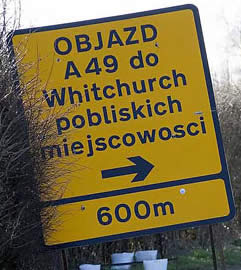Es i i’r côr meibion am y drydedd tro yr wythnos hon. Yn raddol dw i’n mynd yn fwy cyfarwydd gyda geiriau ac alawon y caneuon ac gyda chleff y bas. Gartref dw i’n ymarfer chwarae’r alawon ar y gitâr ac yn canu ar y un pryd. Bydd y côr yn perfformio mewn llawer o gyngherddau eleni – o leiaf unwaith y mis – ac bydd ein cyngerdd cyntaf ar yr 2 Chwefror yn Seaford. Ddydd Mercher mi brynais siwt ginio, crys gwisg a thei cwlwm coch fel y ddraig ar y fanner Cymru i wisgo yn y cyngherddau. Mi ges i ostyngiad mawr ar y preis – pumdeg y cant – oherwydd y seliau mis Ionawr.
Ddydd Iau ymunais â’r Gerddorfa Werin Sussex, grŵp o gerddorion gwerin sy’n chwarae cerddoriaeth o bob cwr Brydain ac Iwerddon dwywaith y mis yn Worthing. Maen nhw’n chwarae ar gyfer dawnsiau sgubor a digwyddiadau tebyg o bryd yw gilydd hefyd. Er enghraifft, neithiwr chwaraeon nhw yn nghinio Burns, ond chwaraeais i ddim achos dim ond newydd ymunais â nhw yw i.
Nuacht
Chuaigh mé chuig an cór ar an tríú uair an seachtaine seo. De réir a chéile tá mé ag éirí níos aithnidiúil leis foclaí agus foinn na hamhráin, agus ar an dord-eochair. Sa bhaile bím ag cleachtadh na foinn ar an giotár agus ag canadh ag an am ceanna. Beidh an cór ag seinn i go leor ceolchoirmeacha i mbliana – uair amháin gach mí ar a laghad – agus beidh an chéad cheolchoirm ar an 2 de Mhí Feabhra i Seaford. Dé Céadaoin cheannaigh mé culaith dinnéir, léine feisteas agus carbhat cuachóige dearg mar an dragan ar bhratach na Breataine Bige, agus caithfidh mé iad ag na ceolchoirmeacha. Fuair mé lascaine mhór – caoga faoin gcead – de bharr díolacháin Eanáir.
Déardaoin chuaigh mé chuig Ceolfhoireann na nDaoine Sussex, grúpa daoine a bhíonn ag seinn ceol as gach coirnéal Breataine agus na hÉireann dhá uair sa mhí i Worthing. Bíonn siad ag seinn ag damhsaí scioból agus gníomhaíochtaí cosúla ó am go ham fosta. Mar shampla, sheinn siad ag dinnéar Burns aréir, ach ní sheinn mise mar ní mo ná go bhfuil mé téigh iontu agam.
News
This week I went to the Welsh choir for the third time. I’m gradually becoming more familiar with the words and tunes of the song, and with the bass clef. I practise the tunes on the guitar at home and try to sing them as well. The choir will be performing in quite a few concerts this year – at least one a month – and the first one will be on 2nd February in Seaford. On Thursday I bought a dinner suit to wear at the concerts. It came with a dress shirt and bow tie that’s red like the dragon on the Welsh flag and I got a big discount – 50% – thanks to the January sales.
On Thursday I joined the Sussex Folk Orchestra, a bunch of people who play folk music from every corner of Britain and Ireland a couple of times a month in Worthing. The also play at barn dances and for similar occasions from time to time. Last night, for example, they played at a Burns Night dinner, though I didn’t play as I’ve only just joined them.
